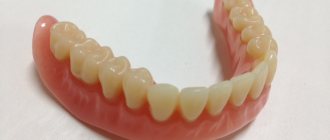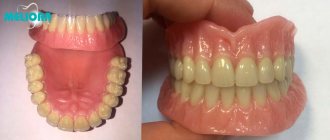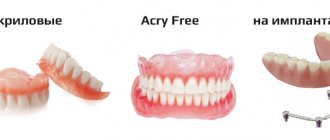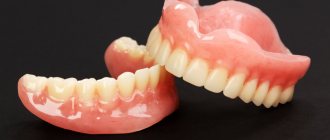If 3 teeth are missing, the patient can be helped with a removable denture, dental bridge or implantation. Implantation of implants is the preferred option: it provides high aesthetics, preservation of adjacent elements and bone tissue (bone atrophy is stopped), reliability and durability. The choice of implantation method depends on the location of the defect.
- When used:
missing 3 teeth - Type of anesthesia:
local anesthesia - Procedure time:
from 45 minutes - Treatment period:
up to 4 months - Healing period:
up to 7 days - Age restrictions:
from 18 years old
Reasons for missing teeth
1-2% of the population has a genetic disorder in which teeth are initially absent or their number is abnormally small. In the vast majority of cases, the absence of lower or upper teeth is a consequence of illness or mechanical damage. Doctors at the clinic name the main reasons:
- Untreated caries or pulpitis. Tooth tissues are destroyed, in advanced cases, inflammatory processes in the gums begin, and the bone structure changes. Our dentists try to preserve every unit. But, if the process is already irreversible, then it is necessary to remove one tooth or several.
- Inflammatory processes in periodontal tissues lead to the fact that the ligament cannot hold the tooth in the socket. The crown becomes loose, destructive phenomena progress, and the gums and bone are destroyed.
- Injuries. The complete absence of teeth or partial adentia is caused by dislocations, bruises, fractures of the tooth crown or root, and other damage resulting from mechanical impact.
Sometimes teeth can be lost after suffering from somatic diseases: oncological, endocrine, and others that weaken the immune system and affect the structure of tissues.
How long does it take to implant multiple teeth? Are there any special features?
The duration of treatment is calculated depending on the degree of complexity of the clinical case, existing concomitant diseases, and the required preparation. On average, if serious therapeutic and orthodontic treatment is not required (therapy of multiple caries, correction of malocclusion and tooth growth), you can invest in 1-2 visits to the clinic:
- Initial consultation . Inspection, questioning (30-40 minutes).
- Preparation . Diagnostics (CT), 3D planning, testing.
- Implantation (30-60 minutes). If you need to remove a tooth, take 20-30 minutes longer.
- Orthopedic stage (+20-30 minutes). Occurs on the day of implantation or within 1-3 days.
Before permanent prosthetics, it will be necessary to take impressions and make prostheses in accordance with the relief of the soft tissues. This takes about a week.
The implant healing period ranges from 3 to 6 months and depends on which jaw is missing teeth, the characteristics of the installation and the state of health.
Why do you need to restore your teeth?
Edentia is not only discomfort, but also early aging. The absence of teeth leads to changes in facial features, sunken cheeks, and the appearance of deep wrinkles. The person looks older, his appearance becomes sickly. In addition to visible imbalances in proportions and a deterioration in the quality of life, when there are no teeth at all, health problems
:
- The diet is reduced, the body does not receive the required amount of vitamins and minerals. The immune system suffers, metabolic processes are disrupted, and cells do not receive enough nutrients.
- Gastrointestinal diseases are provoked. Food is chopped poorly, making digestion difficult. Sometimes patients switch to eating pureed food or pureed food - this method also contributes to the appearance of dysfunction of the stomach and intestines.
- The absence of teeth in the jaws leads to improper distribution of the load on the gums and bone. Tissues atrophy and become thinner.
The bite also changes, diction is impaired - speech is slurred, most sounds are distorted. The absence of teeth affects the emotional state, lowers self-esteem, and the circle of friends narrows. Researchers have also established a direct connection with the presence of teeth and the state of intelligence and activity of older people.
What preparation is required before implantation of several teeth? Why quit smoking?
The doctor at our clinic will recommend strengthening your oral hygiene. You will also have to treat caries, gingivitis and other diseases. If there is plaque, an Air Flow cleaning may be necessary. Teeth whitening is not done at this stage, preferring to do it before permanent dentures.
Smoking must be stopped for the entire duration of treatment, and not just at the preparation stage. Nicotine has a negative effect on tissue, constricting blood vessels and reducing blood flow. This means that the bone around the implant will not receive enough nutrients and will not be able to effectively and quickly increase its volume and density.
Features of complete prosthetics
The clinics of the German Implantology Center in Moscow are a team of expert dentists who constantly improve their skills, participate in domestic and foreign symposiums, and introduce innovations. For more than 11 years of successful dental practice, we have been able to become a leader not only in Moscow, but also in Russia in the field of implantation and prosthetics.
Therefore, dental restoration in our clinics is as comfortable and painless for you as possible - safe anesthesia and sedation are used. The doctor tells you what symptoms may appear in the first days after surgery and prescribes medications appropriate to the case. The doctor is always in touch with the patient until complete healing.
Comparison of complete dentures
Comparison of complete dentures
| Nylon | Acrylic new generation | Acry Free | |
| Aesthetics - the appearance of the structure | High | Average | High, the gums are translucent and look very natural |
| Materials used | Nylon | Acrylic with added diamond chips | Polymer based on acrylic resins |
| Allergic reactions | Possible | Possible | Dentures are hypoallergenic |
| Elasticity | High – stretches over time and is poorly fixed, leading to acute bone atrophy | Low – the prosthesis is quite dense and keeps its shape | Moderate – the prosthesis maintains its shape throughout the entire period |
| Reliability of fixation | Low due to prosthesis stretching | Average | High |
| Wearing comfort | Average | Average | High |
| Possibility of repair | No | Yes | Yes |
| Life time | up to 5 years | up to 5 years | 5-7 years |
| Price | High | Low | Average |
Removable dentures, especially when restoring all teeth, must first of all be comfortable and securely held in the oral cavity. Therefore, if financial capabilities allow, it is best to choose modern designs that are created from innovative new generation materials - these are Acry Free and Quattro Ti. The gums of such dentures are transparent - thus the structures look more natural. In addition, they are moderately elastic, so they fit snugly to the gums, but do not stretch like nylon ones. That is, thanks to this property, they are securely held in the mouth even at the end of their service life. At the same time, such prostheses are very soft, which reduces the period of adaptation to just a few days.
Patient history
“Extra teeth were removed professionally, quickly, painlessly, and a prosthesis was made and installed. There was discomfort for some time, but I began to train. And now I feel that I have good helpers in my mouth that allow me to eat and, most importantly, smile!”
watch a video with the patient
What patients say about treatment
Anna Viktorovna After complex basal dental implantation
Natalya Anatolyevna Thank you to the doctor for the comfortable dentures!
— After complex basal dental implantation
With the attending doctors - implant surgeon Evgeniy Zhilenko and orthopedic dentist Zhargal Dulgarov - after basal implantation of all teeth. Fixed dentures are fixed on the 3rd day after installation of the implants, thanks to which the patient can live a full life and smile openly. The patient also underwent one of the first preventive examinations, which are provided free of charge at Smile-at-Once as part of the post-implant service.
Anna Viktorovna
After complex basal dental implantation
Doctor: Specialization: Experience:
3 days
View all reviews
— Thanks to the doctor for the comfortable dentures!
Natalya Anatolyevna is very grateful to her doctor, orthopedic dentist Yuri Vasin, for making comfortable and aesthetic removable dentures.
Natalya Anatolyevna
Thanks to the doctor for comfortable dentures!
Doctor: Specialization: Experience:
from 5 days
View all reviews
Prosthetics of the upper jaw on implants
Implantation in the complete absence of teeth in the upper jaw has its own nuances: osteoporosis of the bone progresses faster, there is an anatomical feature - a low alveolar ridge (its height is not enough to hold the pin), and the proximity of the maxillary sinus complicates the process.
The classic two-stage method is rarely used in this case. Bone grafting is an additional surgical intervention, and our doctors perform surgery when it is unavoidable. Therefore, preference is given to immediate implantation or gentle techniques.
All on 4 systems
"or "
All on 6
" allow you to quickly, with minimal trauma, restore the dentition when complete dental prosthetics are required in the upper jaw. These techniques are suitable for those who want to get quick and high-quality results. They are well tolerated by older people. If you replace your teeth completely, the healing time of the implants will be up to six months.
The “All on 4” and “All on 6” protocols differ in the number of supporting implants. The first method is suitable for patients with slight thinning of the bone and a small jaw, the second is acceptable for moderate and severe atrophy.
When implanting “All on 4”, two (four) implants are installed at an angle of 35-45 degrees in the lateral (sometimes distal) section, and two more are installed vertically on the front part of the jaw. Implantation at an angle allows you to bypass the maxillary sinuses. Doctors prefer to install dental implants in a minimally invasive way - through a puncture.
If it is not possible to install 4 implants in the complete absence of teeth, then it is possible to implant 2 pins, which will support a removable denture - the structure will be fixed better than the simple version with suction cups, the use of additional gels is not required.
When the tubular bone is too thin, a sinus lift will be required - this is how the volume of the maxillary sinuses is reduced and the bottom is corrected (raised). The voids are filled with synthetic material biocompatible with tissues. Implantation is possible approximately two months after the sinus lift.
If inflammatory diseases are observed (sinusitis, sinusitis), there is a cyst, or a deviated nasal septum, then bone grafting is performed only after anomalies have been excluded - treatment or surgery.
One of the features of implantation in the absence of teeth in the upper jaw is that the front teeth and part of the gums are visible when talking or smiling. Therefore, doctors solve two important problems: restore health and create an aesthetic image. Often artificial teeth turn out to be more beautiful than those given by nature and form the natural contour of the gums. The exact location of the implant is determined based on diagnostic images.
If the bone tissue deficiency is too acute and the augmentation operation is irrational, then it is possible - but at the stage of temporary prosthetics - to install zygomatic implants. In this way, it is possible to replace teeth completely with a small amount of spongy bone mass.
- Extended pins guarantee reliable fixation of the prosthesis in cases of total bone tissue deficiency, osteomyelitis and other clinical cases.
- Titanium implants from the Nobel Biocare line with a porous surface and a special coating are designed for rapid osseointegration.
- Artificial roots are implanted through surgery under anesthesia, bypassing the paranasal sinuses, into the deep cortical layer of the zygomatic bone. This is a complex operation, which is used only in special cases.
Before the operation of implantation of implants in any jaw, the doctor draws up a detailed treatment plan, because not only the beauty of the structure, but also the adequate distribution of the load on the artificial tooth root depends on the accuracy of each action and the correct selection of models of implants and prostheses.
Example #3. Prosthetics of the upper jaw on 8 implants
Our patient is quite young. I contacted the German Implantology Center with the problem of swelling, swelling, bleeding gums, discomfort, accompanied by periodic pain.
Based on the diagnostic results, it was found that all (!) of the existing teeth in the upper jaw are completely untenable due to the previously not entirely successful treatment in other clinics. Unfortunately, this problem is quite common:
The result of implantation and prosthetics of example #3 is presented below:
This clinical case is reviewed in more detail HERE.
Example # 3.1 - Upper jaw prosthetics on 7 implants
Our patient is a 70-year-old man
. I contacted the German Implantology Center with the following problem:
- There are only a few teeth left on the upper jaw,
- Some of the destroyed teeth were roots.
Before making a decision, the patient was constrained by the fact that there were 7 teeth left in the upper anterior section. They provided some (tolerable for many men) aesthetics. But when the man finally fully analyzed the situation for himself, he realized that chewing with so many teeth was, to put it mildly, uncomfortable for him and agreed to a step-by-step and rather complicated dental prosthetics procedure for him. Why was dental prosthetics difficult? Because it was done in several stages, and not all at once in one operation.
We will also not dwell on this clinical case now; we will show BEFORE and AFTER photos.
This is the situation a patient came to us
:
And this is what we have as a result of prosthetics
:
You can view this rather complex clinical case in detail HERE.
Permanent prosthesis on 4 implants – types and prices
We have already said above that 90% of all permanent fixed dentures on 4 implants are titanium-polymer dentures. They are made on the basis of a milled titanium beam, which will be lined on the outside with acrylic plastic or ceramic composite (this is a mixture of acrylic plastic and ceramic microparticles). Now we will look at the pros and cons of each type of prosthesis.
1) Acrylic prostheses with titanium bar –
A permanent fixed denture on 4 implants, made on a Nobel-Procera titanium bar, where artificial teeth and the base of the prosthesis will be made of acrylic plastic, will cost 370,000 rubles. The warranty for such a prosthesis is usually about 5 years, and its service life is more than 10 years. If a non-original titanium beam is used in the manufacture of the prosthesis, the price will be lower - from about 300,000 rubles. Photo of prostheses (Fig. 21-22).
2) Ceramic composite prostheses with a titanium bar –
This version of the prosthesis is similar to the previous one, but instead of acrylic plastic, a ceramic composite will be used, from which both artificial gums and artificial teeth will be made. If the prosthesis is made on the original Nobel Procera titanium beam, then its cost will be from 400,000 rubles. If a non-original titanium beam is used - about 340,000 rubles. The warranty for such a prosthesis is usually 5 years, the service life is more than 10 years.
It should be noted that, in fact, the service life of a titanium beam is lifelong, because it is almost impossible to break it. However, artificial teeth made of acrylic plastic or ceramic composite tend to gradually wear out, which will require reinstallation of artificial teeth in the prosthesis (replacing old artificial teeth with new ones is carried out on average once every 7 years).
Titanium-polymer prostheses –
Inexpensive alternative to titanium bar dentures:
Some clinics offer the following economical option for a permanent prosthesis. As a supporting frame, not a milled titanium beam will be used, but a beam made by casting from a nickel-chrome alloy. The artificial teeth and artificial pink gum will be made from acrylic plastic. For this option of a permanent denture on 4 implants, the price will be only from 180,000 to 200,000 rubles. If instead of acrylic plastic a ceramic composite is used - from 200,000 to 230,000 rubles.
The warranty on such prostheses is no more than two years, and their service life will be no more than 4-5 years. In no case should this type of prosthesis be made for patients with large jaws and well-defined masticatory muscles, patients with bruxism, and indeed all men under 50 years of age. The frame of such dentures has 5 times less strength (compared to titanium), and simply cannot withstand the chewing load and will burst. In addition, cast frames have a poor fit on the implants, which will mean a higher risk of developing inflammation around the implants.
3) Metal-ceramic bridge prosthesis –
This is a prosthesis option that is better not to do. The original version of such a bridge is made on a milled titanium frame, but it is worth saying that ceramics and titanium are far from the best combination of materials. Titanium gives the ceramics a gray tint, which greatly worsens the aesthetics of the prosthesis (anodizing the titanium frame can more or less solve this problem). Additionally, ceramics on a titanium framework have a higher risk of chipping, and dental technicians generally hate working with this combination of materials.
Another disadvantage of this version of the prosthesis is its very high price, and it will be cheaper to make a bridge from zirconium dioxide. However, there are situations when we can only make this version of the prosthesis. For example, when we need long side consoles for a prosthesis, and at the same time we do not have the opportunity to make a prosthesis on a titanium bar (due to lack of vertical space for prosthetics). But especially for Russia, there is a cheaper option for a metal-ceramic bridge with 4 implants.
In this case, the frame will be made by milling, but not from titanium, but from a cobalt-chromium alloy (CHS). Everything about this prosthesis is good, except for its weight and the presence of overhanging consoles in the prosthesis. The All-on-4 technique implies that the implants will be installed in the teeth position 5-2|2-5, which automatically means that the 6th teeth in the prosthesis are made in the form of overhanging consoles. When such consoles are made not of titanium, but of CHS, they are extremely unreliable and, accordingly, we have a high risk that their CHS frame may burst.
4) Zirconium dioxide bridge –
Of course, this is the most beautiful option for a permanent prosthesis on 4 implants. In this case, the milled frame of the bridge will be made of zirconium dioxide. The original frame is again “Nobel Procera”, but non-original “Prettau” types can also be used. Artificial teeth will also be made of zirconium dioxide using the milling method. The cost of such a prosthesis will be no less than 500,000 rubles. If the artificial teeth in such a prosthesis are made not from zirconium, but from Emax glass ceramics, then the cost will be no less than 550,000 rubles.
All-on-4 bridge made of Prettau ceramics –
The warranty on zirconia bridges is usually up to 10 years, but all ceramic bridges are certainly very expensive. The only more or less inexpensive option for metal-free ceramics is bridge-like prostheses using the Trinia technology (the frame of such prostheses is made of durable fiberglass, and the outside will already be lined with ceramic mass). The cost of the Trinia bridge will be about 250,000 rubles.
Important: if you decide to choose a bridge made of zirconium dioxide, then there are several nuances in the manufacture of the bridge that are important for the patient. It is important how exactly the artificial zirconium crowns will be made. Firstly, they can be made single, and secondly, they can be made in blocks (when several crowns are milled as a single unit). The second option is the best, and in this case the crowns are made in blocks - a block of 6 front teeth + two blocks, including 3 side teeth. Why is this so important?
The fact is that the first option involves many “seams” between the crowns, where pigments and, over time, bacteria will settle (the latter will lead in the distant future to the appearance of an odor from the prosthesis). But when we make artificial crowns in blocks, we have only 2 seams and, accordingly, we solve these problems. By the way, for the same reason, we do not recommend that you make a zirconium bridge in combination with Emax crowns, even if such prostheses have amazing aesthetics.
The fact is that Emax glass-ceramic crowns are made only single (they cannot be milled in the form of blocks with several crowns in each). And, accordingly, such a prosthesis will inevitably darken over time in the area of the seams between the artificial teeth, and an unpleasant odor will also appear. Therefore, the optimal manufacturing option is to use a zirconium dioxide frame in combination with zirconium crowns made in three blocks.
Prosthetics of the lower jaw on implants
The structure of the lower jaw is different - the bone mass is denser and thicker, the installation of a lower prosthesis in the absence of teeth, and the implantation of implants have other features.
“All on 4” protocols, as mentioned earlier, in most cases allow for complete restoration of teeth. The healing process is faster - the vast majority of patients forget about the presence of artificial teeth after three months. This is possible due to the increased density and sufficient height of the bone. The method is recommended for lack of volume (short length, thickness), atypical location of the mandibular canal.
Example #4 - All on 4 implantation with lower jaw prosthetics
Our patient is 82 (!) years old
. For the last 10 (!) years I have been trying to carry out treatment - restoration of the dentition with the help of implants. But, unfortunately for him, it was not successful - the implants were lost for a number of reasons - they did not take root, they became inflamed. But we must give our patient his due - he did not lose hope. A man of very progressive thinking, he understood that the problem was not in his body, but that something else was happening that was preventing him from becoming the happy owner of a high-quality denture on implants.
The result of “All on 4” prosthetics is presented in the photo below:
More details about this interesting clinical case can be found HERE.
Maintenance and care of the prosthesis –
Permanent dentures All-on-4 require a very careful attitude. If you previously had a regular removable denture and cleaning it from plaque and food debris was quite simple, now your time spent on hygiene will immediately increase several times. Unfortunately, this comes at a price for the opportunity to have completely permanent dentures. The biggest difficulty is cleaning the underside of the denture.
A fixed denture does not “lie” on the gums, and between the gum and the lower surface of the denture there will be a rinsing space - where food debris will certainly fall. And, accordingly, with insufficient hygiene, plaque and tartar will be deposited on the lower surface of the denture. To prevent this, it will be necessary to regularly use an oral irrigator, as well as use special super-flosses. In addition, regular cleaning of the denture with a soft toothbrush will be required.
Professional denture maintenance – approximately once every 6 months you will have to visit the dental clinic for a professional cleaning session of the denture (for patients with poor hygiene – once every 3 months). To do this, the screws that secure the bridge to the implants are unscrewed, and the prosthesis is removed from the mouth. The lower surface of the prosthesis is professionally cleaned and polished, and then the prosthesis is again fixed to the implants using screws.
An important point is that the quality of hygiene of the lower surface of the prosthesis will depend not only on your efforts. When making a denture, a dental technician may make mistakes that may not allow the patient to clean the lower surface of the denture at all. Normally, the lower surface of the prosthesis should have a convex shape, but very often we see that the lower surface of the prosthesis is given a concave shape (Fig. 24-25) - it becomes impossible to clean such a surface with floss.
Therefore, patients with a concave shape of the lower surface of the prosthesis always have a large amount of tartar on the prosthesis, always have bad breath, as well as inflammation around the implants, which over time can lead to failure of all implants. But let's see what else you need. Patients with titanium-polymer dentures will have to replace artificial teeth in the denture approximately once every 7 years. The fact is that teeth made of acrylic plastic or ceramic composite gradually wear out (this happens especially strongly in the chewing areas).
Wearing of the chewing teeth will lead to a decrease in the height of the bite in the chewing sections and, accordingly, to an increase in the chewing load on the front teeth (which sooner or later will not withstand the load and will break).
Features of implantation and prosthetics on the lower jaw
The artificial root is more firmly fixed in the tissue, so the risk of rejection tends to zero. The mandibular bone atrophies more slowly after the loss of units, which reduces the likelihood of osteoplasty. For complete dental prosthetics on implants, we use the “All on 6” technique more often in most clinical cases. This guarantees the patient reliability and ease of use of the orthopedic construction, primarily in the long term.
The aesthetic side is important, but when working with the dental row below, more attention is paid to restoring functionality. There is a nuance: the surgeon’s work will require precision, since the trigeminal nerve passes at the base of the jaw and there is a risk of damage to it if the intervention is careless.
- Before implantation begins, during diagnostics the exact location of the branch of the trigeminal nerve is established, the structure of the tissues and the localization of nerves and vessels are clarified.
- Surgeons at the Research Center clinics are highly qualified, carry out diagnostics and know everything about the anatomical features of each patient, so implantation takes place without complications.
- The doctor selects not only the location of the implant, but also its size, which is especially important in the absence of teeth. If the location is too close, then the nerve trunk will need to be docked.
Example #5 - Lower jaw prosthetics on 6 implants ALL ON 6
Our patient is a woman with fairly progressive views on dental treatment and prosthetics. But a rather serious problem in her life is an allergy to antibiotics. Since she categorically did not want a removable denture, considering it archaic and uncomfortable, the patient began her independent attempts to improve her smile. And she did this at her own peril and risk in several clinics.
At first, she installed the implants without “covering up”—the subsequent use—of antibiotics. Some of the implantation went well, some not so much. Having suffered, the patient concluded that she still needed to turn to professionals and then, even without antibiotics, she would get the reliable and aesthetically beautiful result that she dreams of and really wants to achieve.
The photo shows a view of 6 implants installed on the lower jaw:
Photo after prosthetics
:
You can read more about this interesting clinical case HERE.
What to do if three teeth are missing in a row
Restoration of three consecutive missing units of the dentition can be carried out using:
- Installation of a bridge-like prosthesis supported by adjacent teeth - the defect is closed with an orthopedic design of crowns welded together. The outermost ones are attached to living teeth along the edges of the defect, which are previously depulped and ground down.
- Removable prosthesis - made of lightweight materials, used in cases of unsatisfactory condition of the supporting units, inability to withstand the load.
- Implantations - titanium rods are implanted into the jaw, acting as tooth roots, and covered with single crowns or a bridge.
Which prosthetics for the lower jaw is better?
Patients are often interested in which prosthetics are best for restoring lower jaw teeth. Progressive experts believe that implantation and installation of structures today is the optimal and gentle option to maintain quality of life at any age. Root-shaped implants for the lower units are selected taking into account the upcoming high chewing load.
We use the basal method of prosthetics on implants extremely rarely and only at the stage of temporary prosthetics in the distal part as part of the “All on 6 implants” protocol in the absence of teeth, severe tissue atrophy and the inability to install 2 classical artificial roots. Then the elongated implants are introduced into the deep layers of the jawbone during the formation of bone in the distal section after bone grafting. After the bone tissue has formed, the basal implants are removed and normal classical implants take their place. And after this, the patient undergoes permanent prosthetics on 6 implants.
Modern implant designs are characterized by directional threading; some models have a porous surface with a coating that accelerates the integration of the artificial root into the bone. Fixed dentures in the absence of teeth are installed on a larger number of supports, minimum 6-8. One- or two-stage protocols are warranted. In the first option, until complete engraftment, the patient wears a traditional removable denture; in the second, a temporary option with artificial gums attached to pins is installed.
The fixed structure consists of metal-free crowns (usually zirconium dioxide), there is no artificial gum, and there is no need to remove the denture for cleaning. It is enough to follow standard hygiene procedures.
The “All on 4” protocol is ideal for restoring missing teeth in the lower jaw, if it is small, and allows, in most cases, to avoid bone augmentation. This is usually a one-stage implantation with immediate loading. Primary stabilization is high, there is an orthopedic stage. Within a week after the implants are inserted, a temporary prosthesis is put on.
If the bone has atrophied and for some reason it is decided to give preference to classical implantation, then bone grafting will be required. Special membrane materials are used that are embedded in the bone and stimulate its development. After osteoplasty there is a rehabilitation period of 4 months. up to six months.
Methods of prosthetics in orthopedic dentistry “22 Century”
Modern methods of prosthetics in dentistry involve the use of various techniques, the most common of which include:
- Direct implantation . Performed immediately after tooth extraction. It is more effective and of higher quality, since there is no atrophy (reduction in volume) of the part of the alveolar process of the jaw in the area of the missing tooth.
- Delayed implantation . It is carried out in case of long-term absence of one or more teeth. It includes mandatory preparation of the bone bed before implantation.
- Single-phase implantation . It is a one-step implantation of the root part of the implant into the bone bed of the alveolar process of the jaw, followed by installation of the neck and head.
- Two-phase implantation . It involves the gradual introduction of first the root part of the implant, and then, after it has engrafted into the bone tissue, the neck and head are installed.
In the absence of several teeth, the anatomical relationship of the dentition is disrupted. Therefore, during prosthetics on implants, an appropriate correction of the position of the teeth in relation to each other is necessarily made. This allows you to maintain the aesthetic appearance and restore the normal functional state of the jaws, in particular the bite.
We insert the teeth completely: prosthetics of two jaws
Which prosthesis should I choose if I have no teeth at all? Contact the German Implantology Center - the doctor will choose a way to restore your health. Preference is given to implantation. The statement that it is expensive is outdated. Today you can get an installment plan. Implants are installed once and with a lifetime guarantee - clinic dentists work only with the premium segment from well-known manufacturers, and expensive traditional removable structures wear out and require replacement after 7-10 years.
Our Center is a certified partner of top-rated implant brands, which is why patients all over Russia and abroad trust us. If it is necessary to restore the dentition on two jaws, the treating doctor will prescribe an examination and draw up a detailed action plan for dental prosthetics on implants. A tomogram is performed, a 3D model or surgical template is created, providing a predictable result. We use the best tomograph models in the world – cone versions of the Planmeca line.
The dentist chooses the priority of actions and introduces implants according to the “All on 4” or “All on 6” protocols. These are ways to carefully, avoiding unnecessary trauma, improve the quality of life.
Dental implantation is completely performed in most cases without bone grafting.
- For total rehabilitation, sometimes 4 implants are enough to fix the prosthesis on the lower jaw - this is 20% of all requests.
- The bone of the upper jaw is more porous, so 6 supports may be needed to secure the structure - the need to use one of the methods will be discussed by the doctor during a consultation after the examination.
The treatment plan must be discussed with the patient.
Example #6 - Prosthetics of both jaws with implantation ALL ON 6
Our patient is a 49-year-old man. I came across the following difficult situation:
- severe periodontitis,
- partial absence of teeth,
- numerous caries, incl. deep
- bone tissue atrophy.
The situation was more than serious, look for yourself at the photo BEFORE the start of treatment
:
The result of the prosthetics exceeded all the patient’s wildest expectations, see for yourself:
And with a smile, the result of ALL ON 6 is simply fantastically beautiful:
You can read this clinical case in detail HERE.
Advantages of restoration using artificial roots
- Preservation of existing bone volume;
- convenient operation and absolute safety of the design;
- ability to withstand any chewing loads;
- high level of aesthetics;
- quick adaptation to the design;
- complete restoration of dental functions;
- reliable fixation of the bridge, which prevents its displacement;
- no need to depulp and grind adjacent teeth;
- durability - with proper care, implants last a lifetime.











